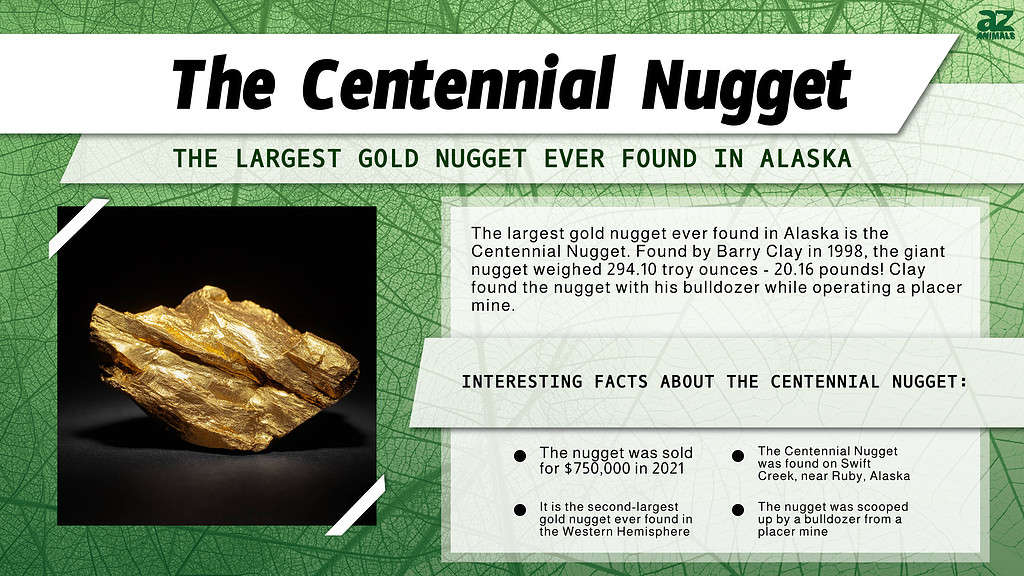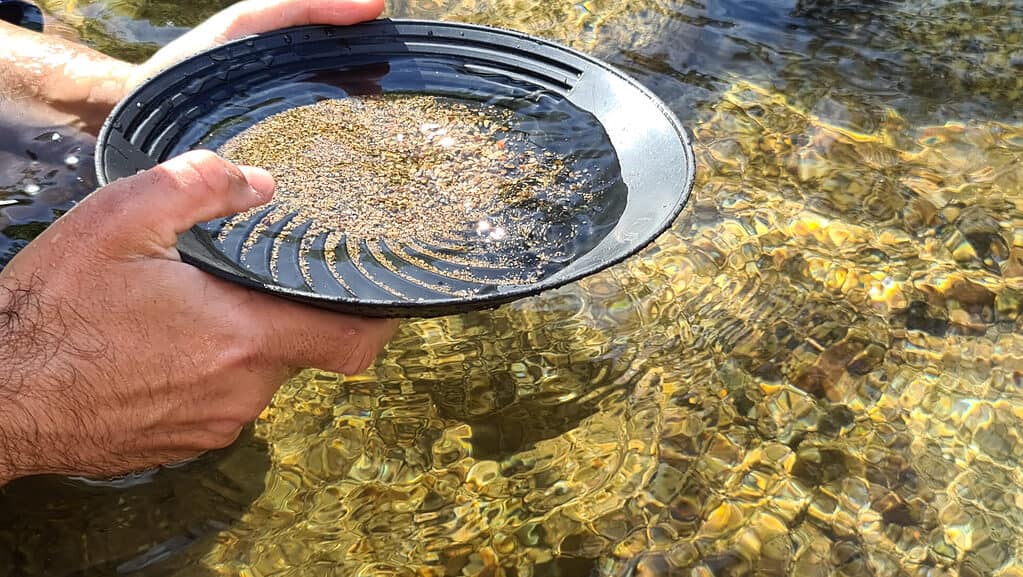
Alaska is easily the largest state in the country. Known as The Last Frontier, this state is famous for both its savage winters and many claims to fame. Among these claims to fame are the veins of gold that run through certain regions and watersheds. But, Alaska’s known for more than its gold, it’s also known for its incredible fishing, and plentiful natural gas and oil. Over half of this northern state’s lands are protected as either wildlife refuges, national parks, or national forests. But, just how big is the largest gold nugget ever found in Alaska?
Read on to learn more about the largest chunk of gold to ever come out of Alaska. We’ll also learn a little about the history of gold mining there. Finally, we’ll find out the size of the largest gold nugget ever found anywhere.
What is the Biggest Gold Nugget Ever Found in Alaska?

Gold nuggets can weigh astonishing amounts – the largest weighs more than 20 pounds!
©Roman Bodnarchuk/Shutterstock.com
The largest gold nugget ever found in Alaska weighs 294.10 troy ounces. That’s a whopping 20.16 pounds! This monstrous chunk of gold, known as the Alaska Centennial Nugget, was discovered by a gold miner named Barry Clay in 1998. Clay was operating a placer mine (surface mining using water to separate the gold from the heavier materials) when he found the giant nugget. In fact, Clay reportedly didn’t even have to dig for the piece—he found it with his bulldozer! Clay’s placer mine was located on Swift Creek, close to the town of Ruby—an area known for producing hefty gold nuggets.
According to Clay, upon his discovery of the watermelon-sized gold nugget, he immediately buried the piece nearby to keep it safe. Then, when he was ready, he transported it for assessment. It was at that time that Clay discovered that his nugget was the largest gold nugget ever found in Alaska. Further, the Alaska Centennial Nugget (as it is now known) is the second-largest gold nugget ever recovered in the Western Hemisphere. The title of largest gold nugget ever found in the Western Hemisphere goes to the Cortez Boot, found in Mexico, which weighs approximately 24 pounds.
How Much is the Alaska Centennial Nugget Worth?
You might be wondering, why is it called the Alaska Centennial Nugget. Well, fortuitously, the largest gold nugget ever found in Alaska was found in 1998—exactly 100 years after the famous Klondike gold rush.
But, just how much is a 20-pound chunk of gold really worth? Well, Clay initially sold the Alaska Centennial Nugget for an unknown price to a private buyer. That buyer held onto the gold for over 20 years, until 2021, when the giant chunk of gold once again went up for sale. In December 2021, the Alaska Centennial Nugget sold for 750,000 dollars to an unknown buyer. Of course, the value of precious metals is entirely dependent on the worth assigned by culture and society. Still, the Alaska Centennial Nugget is an incredibly rare, and beautiful, find.
A Brief History of Gold Mining in Alaska

The Centennial Nugget weighed over 20 pounds.
©iStock.com/bodnarchuk
The gold craze that brought thousands to Alaska in hopes of pulling their family fortune from the mud began in 1896, with a single discovery. In 1896, a man known as Skookum Jim discovered gold in the Klondike River of Canada’s Yukon Territory. Over the next several years, thousands would converge on the area in hopes of finding the largest gold nugget ever found. Or, at least, enough gold to make them rich. But, for most prospectors, the cost of the journey, the time spent searching, and the hardship they faced far outweighed any benefit they gained—if any. Yet, still, over 100 years later, the allure of unearthing gold remains strong for many.
Can You Still Pan for Gold in Alaska?

If you want to pan for gold, your best bet is with a tour guide!
©iStock.com/Kaszojad
Today, many people searching for gold in Alaska do so in two ways. First, by mining or panning their claims, and second, by organizing gold panning tours for tourists. No matter who you are, you probably get a little bit excited thinking about finding a shiny bit of gold in your pan. But, you can’t just go to Alaska and start panning the first river you see. So, yes: you can still pan for gold in Alaska. But, if you want to try it, your best option is to find a reputable tour guide, and remember: have fun!
What is the Biggest Gold Nugget Ever Found, Anywhere?
The Alaska Centennial Nugget might seem like a whopper, but it’s nothing compared to the gold nugget known as “Welcome Stranger.” Unearthed in Victoria, Australia in 1869, this gold nugget weighs in at an astounding 3,523.5 troy ounces—that’s over 241 pounds! That’s right, the largest gold nugget ever found is too heavy for most people to lift. If you’re hoping to see this nugget in person one day, you might be disappointed. Welcome Stranger has melted down into gold ingots decades ago.
Who Has the Most Gold Today?
That question can be answered in a few different ways. Gold mining can be found on every continent except Antarctica, but gold mines vary widely in type and scale. In terms of production per country, China ranks first (about 9% of the world’s total), followed by Australia, Russia, and the United States.
However, in terms of mining operations, the Grasberg complex in Indonesia is one of the largest. Then again, in terms of the greatest concentration of gold, that prize goes to South Africa and India. In fact, the town of Johannesburg, South Africa, is built on top of the world’s largest deposit of gold!
In the United States, where gold mining started in 1799 in North Carolina, Nevada’s large, open-pit, heap-leach mines produce about 75% of America’s gold. Alaska, Arizona, California, and Colorado also have working gold mines. Although the amount varies by year, in 2018, the United States produced 210 metric tons of gold.
Another answer to the question about who has the most gold: The United States has the largest stockpile of gold reserves in the world—almost as much as Germany, Italy, and France, the next in line, combined!
The photo featured at the top of this post is © iStock.com/bodnarchuk
Thank you for reading! Have some feedback for us? Contact the AZ Animals editorial team.






